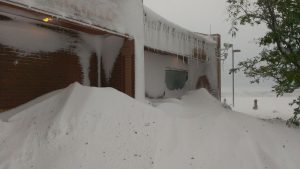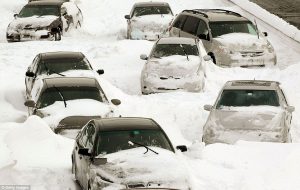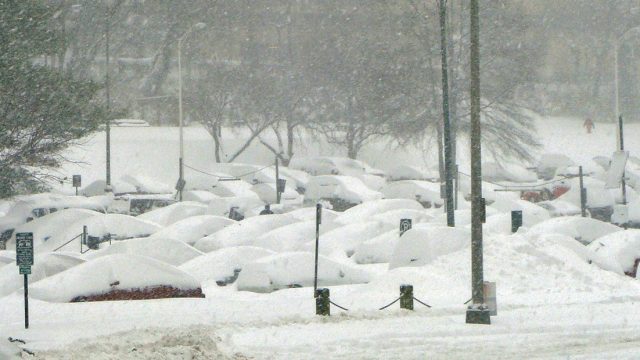With a major winter snow storm hitting a majority of the eastern United States we thought it would be a good time to discuss Preparing for Major Winter Storms.
Heavy snow can immobilize a region and paralyze a city, stranding commuters, closing airports, stopping the flow of supplies, and disrupting emergency and medical services. Accumulations of snow can cause roofs to collapse and knock down trees and power lines. Homes and farms may be isolated for days. In rural areas, unprotected livestock can be lost. In urban areas, the cost of snow removal, damage repair, and lost business can have severe economic impacts.
The problem with Winter Weather Preparedness is a majority of the public tends to think about it 24 to 36 hours prior to an actual storm. While this may be the norm for our society it is best to plan well ahead of these events to limit stress, lack of resources and the panicked public.
Below you will find what you need to have in your Home, Office and Vehicle to be prepared for a Major Winter Storm.

Home Winter Storm Preparedness
Non-Perishable Food – Stock up on canned soups and vegetables, powdered food, and grains like rice and pasta. Make sure you have enough to last your family at least three or four days. Make sure you have a manual can-opener, as well. Freeze dried food is also ideal but remember to have a store of water.
Camping Stove or Grill – A gas-powered camping stove is a wise investment for any emergency situation. If you have an electric stove in the kitchen a camp stove is almost a necessity.
Be sure you use it with proper ventilation to avoid carbon monoxide poisoning, and have plenty of backup fuel.
A great little cooking stove is the Swedish Trangia as fuel sources are abundant and rarely ever depleted at retail stores.
Matches – To light your gas range/camping stove/candles. Do not rely on lighters that can run out of fuel or break down all too easily.
Battery Operated Radio – This way you can get news without wall power. Make sure the batteries are good. It is also possible to buy a motion charging radio, as you can with a flashlight.
Prescription Medications – Like food, it is always wise to have enough to last you a few days.
First Aid Kit – You never know what kind of injuries or emergencies will happen, so make sure you have sterile bandages, disinfectant, antibiotic ointment, and over-the-counter painkillers available.
A Shovel – Even if you live in an apartment you should own a shovel as you may need to dig yourself out before your ground crew gets in, and they are unlikely to dig out your car.
Hurricane Lanterns – Not only do they provide light during a power outage but they also produce heat that can easily heat a room in an emergency.
Cellphone with Cord/Portable Cellphone Charger – Cordless home phones will not work when the power is out. Many states require at least one wall plugged phone, which receives power from the telephone connection, in all households.
If you have a car charger you can always rely on your vehicles battery to charge your phone. However it may be an endeavor getting into your car!
Warm Room – When faced with an extended power outage, living and sleeping in a single room will help conserve heat. If there is an extended power outage during a major winter storm set up a tent in the house. You can sleep in sleeping bags or a mattress in the tent to share heat and warm a smaller area. The tent can also keep kids distracted.
Flashlights & Batteries – Make sure you have good quality flashlights and headlamps with fresh batteries. You can also purchase self-powered flashlights and self-powered radios. Some models will also charge your cell phone.
Anything else vital to your household – You should always have ample supplies of items like diapers, formula, pet food, and so on before the storm hits.

Office Winter Storm Preparedness
Most employer’s and employee’s do not think about an event where they are stuck at the office due to inclement weather. But it happens more often than not!
While driving home may be treacherous at times there may be instances where you cannot even leave your office parking lot, let a lone get to your vehicle.
It is ideal to have an Office Preparedness Kit that includes but not limited to these basics (Many of these are a blend between your Home and Vehicle Winter Storm Preparedness Kits). These basics are small enough to fit into a utility closet.
Non-Perishable Food – Stock up on canned soups and vegetables, powdered food, and grains like rice and pasta. Make sure you have enough to last your family at least three or four days. Make sure you have a manual can-opener, as well.
Camping Stove or Grill – A small compact gas camping stove is ideal to feed a few employee’s. Make sure every employee is versed on how to work the camping stove/grill in case anyone is stranded there so they all know how to operate it.
Matches – To light your gas range/camping stove/candles. Do not rely on lighters that can run out of fuel or break down all too easily.
Battery Operated Radio – This way you can get news without wall power. Make sure the batteries are good. It is also possible to buy a motion charging radio, as you can with a flashlight.
Prescription Medications – You should have this in your Vehicle Emergency Kit
First Aid Kit – Your office should have a first aid kit but make sure it is well-rounded. This includes but not limited to sterile bandages, disinfectant, antibiotic ointment, and over-the-counter painkillers available.
A Shovel – Most businesses have a shovel or a snow blower. It is a great idea to have more than three on hand as there may be more than one employee stranded and more than one hand shoveling out cars is better than one!
Hurricane Lanterns – Not only do they provide light during a power outage but they also produce heat that can easily heat a room in an emergency.
Cellphone with Cord/Portable Cellphone Charger – Cordless home phones will not work when the power is out. Many states require at least one wall plugged phone, which receives power from the telephone connection, in all households.
Blankets – A majority of offices do not have secondary backup heating sources so blankets will be your lifeline if the power goes out.
Warm Room – Same with Home Emergency Plan make sure you have a room in your office, preferably a central location that does not get drafts, to hunker down in.
Flashlights & Batteries – Make sure you have good quality flashlights and headlamps with fresh batteries. You can also purchase self-powered flashlights and self-powered radios. Some models will also charge your cell phone.
Bottle of water and a few protein, snack bars – In case someone in your office has been eating the food stores that are meant for an emergency stash a few bottles of water, protein bars and jello boxes in your desk. This way you wont be starving to death when you find Fat Phil ate all the survival food stores at the office!
Employee Contact List – You may need to call employee’s families letting them know that they are safe or have left and to expect them soon. This way if for some reason an employee gets stranded the family can send out help.

Vehicle Winter Storm Preparedness
In the unfortunate event that you are stranded in your car due to heavy snow fall or automobile problems it is wise to have a Vehicle Emergency Bag in your trunk.
Some auto parts stores and mass merchandisers like Walmart or Target sell these as a bundle in their own carrying case. But we highly recommend building your kit to fit your needs based on your areas winter weather.
Blankets – If you are stuck with a car that won’t start, or that has conked out, and have to wait in cold weather for help, you will want a decent warm blanket as an extra layer.
Snow shovel – Get a short-handled shovel, probably a coal-type shovel, to stow in the trunk in case you need to remove snow from around the wheels of your vehicle.
You can buy plastic ones, but you may want to opt for a metal one in case you also need to chip at some ice or compacted snow.
A quality all metal shovel is critical as you will most likely need it most!
Flashlight – Self explanatory. Keep a good-sized, water-proof flashlight with fresh batteries in case your breakdown is at night. Pack emergency candles too, as a back-up.
Hand warmers – Available at many retail stores. Smash the bag and the chemical reaction inside creates warmth to defrost fingers that may be trying to change a tire or fiddle with an engine.
Matches – You never know when you will have to manufacture heat. It’s better than rubbing two cold, snowy sticks together, hoping for the best.
Bottle of water and a few protein, snack bars – You hear of people surviving on ketchup packets that have fallen between the seats, but some planning will yield a better menu under emergency conditions.
Syphon Pump – If being out of gas is your problem, and you get offered help by a good samaritan, you want t be able to get a gallon or two of gas out of another gas tank to get you going quickly.
Candles – Yes you can have a candle in the car. Just have it at a central location and do not move around too much. 9 hour, 15 hour and even 36 hour candles are ideal and lightweight for Vehicle Emergency Kits
Lightsticks – These cost almost nothing at a dollar store and can be used either as a iight source or to wear in case you are shoveling snow around your wheels at night.
Flares – These should be in your trunk in all seasons for putting next to your car if you are pulled over in distress. Use chemical light sticks as an alternative.
Whistle – It can be used to either signal for help to someone who can’t hear you yell, or to scare someone who may be trying to take advantage of your distress.
Extra Winter Clothes – Always have an extra set of clothes in case your current one get wet or damp. Wet clothes will kill in a snow storm when temperatures plummet.
Make Sure Your Car is Full of Gas – You may need to go out before everything is operational. It is a rule of thumb in the Emergency Outdoors family to never have your car go below half a tank.

